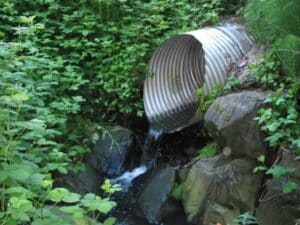Water Pollution Discharge Permits
The Clean Water Act and Water Pollution Discharge Permits
Under the Clean Water Act water pollution discharge permits are required for pollution through pipes. Generally, the U.S. Environmental Protection Agency (EPA) authorizes states to issue these permits. Called the “National Pollutant Discharge Elimination System” (NPDES), these permits last for five years. However, so long as a permittee has applied for a new permit six months prior to expiration, the existing permit will last forever. These are referred to as “administratively extended” permits or, more to the point, “zombie permits.”
A snapshot of Oregon’s NPDES permit program shows that it has far more zombies than current permits. And, in 2016, the Oregon Department of Environmental Quality (DEQ) admitted that it was issuing illegal permits. By contrast, Washington looks like it has a very alive permit program. Look past the dates on the permits, however, and you find that Washington’s program is all appearances and no content. The permits are simply illegal because they fail to control pollution as required by the Clean Water Act. Both states’ programs are grotesque failures.
Requiring the Best Technology to Limit Pollution
NPDES water pollution discharge permits are supposed to reflect two separate prongs of the Clean Water Act: what is available in pollution control technology and what the water needs to stay clean. The first prong, called the “technology-based approach,” requires that all dischargers across the United States that do similar things use a minimum treatment technology for their wastes. The EPA establishes these “national effluent guidelines” and dischargers are free to figure out how to achieve them. But the idea is to advance pollution elimination, to make sure that, for example, all steel manufactures use the best available treatment technology for the wastes they produce making steel, regardless of the qualities of the river into which they discharge—what size of river, how polluted it is, or who else is discharging to that river.
Protecting Water Quality
After determining the technology-based requirements, a permit writer is then required to evaluate whether that treated discharge might still cause or contribute to violations of water quality standards. If the answer is yes, the facility’s permit will also have to include a “water quality-based effluent limit.” This water quality-based approach is the opposite of the technology-based approach; it’s all about the size of the river, how polluted it is, and who else is polluting it. It is not about whether technology is available to clean up dischargers; it’s about restricting the amount of pollution as needed to protect public health and aquatic species. These limits are based on state water quality standards.
The Public’s Role in Permitting

An Elegant Design, Deeply Flawed in Implementation
The Clean Water Act is elegantly designed. As water quality-based pollution limits are imposed where they are needed, it drives the development of improved pollution clean-up technology. Over time, the law is designed so that EPA will make those improved technologies required for every discharger in that class of pollution sources. Over time, under this scheme, pollution would inch closer to being completely eliminated. Unfortunately, EPA is very slow at establishing and updating the national effluent guidelines that establish minimum treatment technologies. And permitting agencies have a large bag of tricks to avoid imposing any additional water quality-based limits on pollution sources. One way this is done is through the Oregon zombie permit approach, in which sources simply continue to discharge under very old permits. Another way is the Washington living dead approach, in which sources are repeatedly issued illegal permits that fail to contain the limits that the law requires. Whether zombies or walking dead, the result is the same: public waters stay polluted. While EPA maintains oversight authority over these state permit programs, it overlooks their deep flaws.
How Mixing Zones Undermine the Clean Water Act
Although not included in the Clean Water Act, EPA devised a concept called the mixing zone many decades ago. Very simply, mixing zones give dischargers a free pass to violate water quality standards within a plume of pollution from their pipes. By conducting the analysis of whether a polluter is meeting water quality standards after its discharge has been diluted with river water, a permitting agency is allowing far more pollution than requiring compliance at the end of a pipe.
Take a Flawed Program and Then Add a Scam
In Oregon, as the state has worked to avoid causing pollution sources to have to clean up their pollution, it has promoted the idea of water pollution trading. Although there are different ways to trade, the basic approach is to allow a source with a permit to undertake some pollution controls for a source that does not require a permit, such as a farmer. Farmers are not required to do anything to stop polluting public waters so allowing a sewage treatment plant to plant trees along a riverside to prevent sediments, pesticides, and nutrients from entering a river has facial appeal. And, in Oregon, where the majority of streams are suffering from temperature pollution caused primarily by the lack of streamside shading, planting trees is greatly needed to keep water cool and encourage groundwater exchange. However appealing in theory, the practice of water pollution trading turns out to be far more scam than solution.
